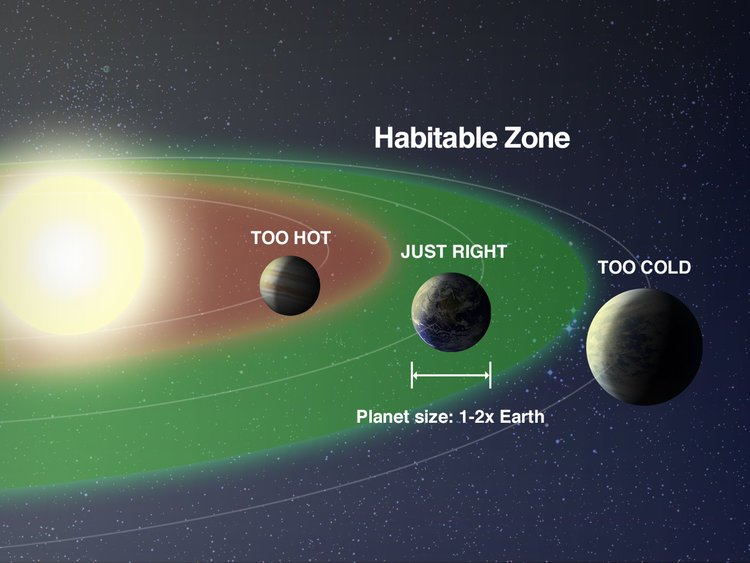In the vast expanse of the cosmos, the search for life beyond Earth has captivated humanity’s imagination for centuries. Among the myriad stars and planets scattered throughout the universe, scientists have identified a unique region known as the “Goldilocks Zone” or “habitable zone,” where conditions may be just right for life to flourish. In this article, we will explore the concept of the Goldilocks Zone, its significance in the search for extraterrestrial life, and the exciting discoveries of potentially habitable exoplanets.
What is the Goldilocks Zone?
The Goldilocks Zone refers to the circumstellar habitable zone around a star, where conditions are neither too hot nor too cold for liquid water to exist on a planet’s surface—the essential ingredient for life as we know it.
- Importance of Liquid Water: Liquid water is fundamental to life’s existence, serving as a solvent, medium for chemical reactions, and habitat for microbial and multicellular organisms. The presence of liquid water is considered a key indicator of a planet’s potential habitability and the Goldilocks Zone’s defining criterion.
- Stellar Characteristics: The location and extent of a star’s habitable zone depend on its size, temperature, and luminosity. Main-sequence stars, similar to our Sun, have well-defined habitable zones, while smaller M-dwarf stars and larger, hotter stars exhibit different zone boundaries, influencing potential habitable regions within a planetary system.
Factors Influencing Habitability
While the Goldilocks Zone provides a general framework for assessing a planet’s potential habitability, various factors and conditions contribute to a planet’s suitability for life.
- Atmospheric Composition: A planet’s atmosphere plays a crucial role in maintaining surface temperatures, regulating greenhouse gases, and shielding against harmful radiation. The presence of a stable atmosphere with the right composition, pressure, and temperature range enhances a planet’s habitability and potential for hosting life.
- Geological Activity: Geological processes, including plate tectonics, volcanism, and the carbon-silicate cycle, contribute to a planet’s climate stability, surface conditions, and nutrient cycling. Active geological activity supports habitable environments, fosters chemical diversity, and sustains ecosystems over geological timescales.
- Stellar Characteristics: The type, age, and variability of a star influence a planet’s climate, radiation environment, and potential habitability. Stable, long-lived stars with consistent energy output provide favorable conditions for life to evolve and thrive within the habitable zone.
Discovering Habitable Exoplanets
Advancements in observational astronomy, space missions, and exoplanet research have revolutionized our understanding of planetary systems and expanded the search for habitable worlds beyond our solar system.
- Transit Method: The transit method, employed by missions like NASA’s Kepler Space Telescope and TESS (Transiting Exoplanet Survey Satellite), detects exoplanets by measuring the slight dimming of a star’s light as a planet passes in front of it. This technique has identified thousands of exoplanets, including potentially habitable worlds within their star’s Goldilocks Zone.
- Radial Velocity Method: By observing the periodic Doppler shifts in a star’s spectral lines caused by an orbiting planet’s gravitational tug, astronomers can determine a planet’s mass, orbit, and potential habitability. Ground-based telescopes and spectroscopic surveys use this method to discover and characterize exoplanets orbiting nearby stars.
- Direct Imaging: Advanced imaging techniques and next-generation space telescopes, such as the James Webb Space Telescope (JWST) and ground-based observatories, aim to directly image exoplanets and analyze their atmospheric compositions, surface conditions, and potential signs of life. Direct observations provide invaluable insights into exoplanet properties, habitability, and the search for biosignatures.
The Quest for Life Beyond Earth
The discovery and characterization of potentially habitable exoplanets fuel humanity’s curiosity and inspire ongoing efforts to search for life beyond Earth.
- Biosignatures and Atmospheric Analysis: Analyzing exoplanet atmospheres for specific gases, such as oxygen, methane, and water vapor, offers clues about biological activity, surface processes, and potential habitable conditions. Advanced spectroscopic techniques and future space missions aim to detect and interpret biosignatures indicative of life, such as atmospheric disequilibrium and complex organic molecules.
- Astrobiology and Interdisciplinary Research: Astrobiology, the study of the origin, evolution, and distribution of life in the universe, integrates insights from astronomy, biology, chemistry, geology, and planetary science to explore habitable environments, extremophiles, and the potential for life’s existence beyond Earth. Collaborative research, interdisciplinary approaches, and innovative methodologies drive progress in astrobiological research and the search for extraterrestrial life.
- Future Space Missions and Observatories: Planned missions, including NASA’s LUVOIR (Large UV/Optical/IR Surveyor), HabEx (Habitable Exoplanet Observatory), and ESA’s ARIEL (Atmospheric Remote-sensing Infrared Exoplanet Large-survey) mission, will advance exoplanet research, enhance detection capabilities, and enable detailed studies of habitable exoplanets and potential life-bearing worlds. These ambitious projects promise groundbreaking discoveries, technological innovations, and transformative insights into the nature of life in the universe.
Conclusion
The Goldilocks Zone, with its tantalizing promise of habitable worlds and potential for life’s existence beyond Earth, stands as a beacon of exploration, discovery, and wonder in our cosmic journey through the universe.
As we continue to explore, investigate, and unlock the secrets of the cosmos, the search for habitable exoplanets and signs of extraterrestrial life inspires humanity’s imagination, curiosity, and pursuit of knowledge. Through collaborative efforts, innovative research, and a shared passion for exploration, we draw closer to answering fundamental questions about life’s origins, diversity, and existence in the vast expanse of space and time.
In the grand tapestry of the universe, the Goldilocks Zone serves as a reminder of the delicate balance, extraordinary diversity, and boundless potential for discovery that await us in the exploration of the cosmos and the quest to understand our place within the vast cosmic landscape of stars, planets, and the myriad possibilities that the universe holds for life’s existence and evolution.
